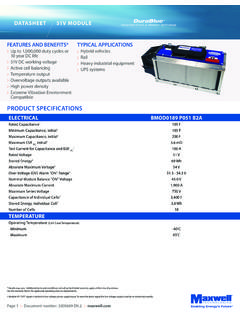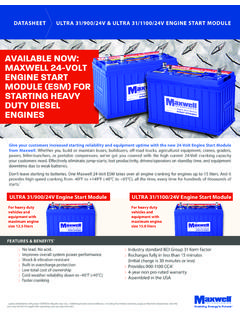Transcription of The testing outlined below will ... - Maxwell Technologies
1 PRODUCT GUIDE Maxwell Technologies BOOSTCAP Ultracapacitors TABLE OF CONTENTS 1 Description of Double Layer Capacitors 4 Theory 4 Construction 5 2 Typical Applications 6 Pulse Power 6 Bridge Power 7 Main Power 7 Memory Backup 7 3 Determining the correct Ultracapacitor for the application 8 4 Specifications 10 Specification Description 10 Measurement Conditions 13 Capacitance 13 Resistance 13 Leakage Current 14 5 Performance Characteristics 15 Temperature Effects.
2 Initial Performance 15 Voltage and Temperature Effects on Life 16 Cycling 18 Frequency Response 19 6 Packaging 27 Typical Packaging Quantities 27 Shipping Regulatory Information 27 General Packaging Requirements 28 Specific Packaging Requirements 28 Excepted Quantities 28 Limited Quantities 29 Passenger Aircraft limitations 29 Cargo Aircraft limitations 30 7 Design Considerations 31 Voltage 31 Safety considerations about the voltage 31 Electrical Isolation 32 Ambient Temperature 32 Safety considerations about temperature 33 Humidity 34 Pressure 35 Polarity 35 Product Guide Maxwell Technologies BOOSTCAP Ultracapacitors Doc.
3 No. 2009 Maxwell Technologies , Inc. Page 2 Charging 36 Series Connection 36 Voltage Management 37 Passive Balancing 37 Life 37 Capacitor replacement 38 8 Mechanical integration and interconnecting Methods 40 Shrink Sleeve 40 Terminal Cleanliness 40 Buss bar considerations 46 Mechanical fastening 47 PC Ultracapacitor Mounting Considerations 41 Bending of
4 The terminals 41 Soldering the Cells 41 BC Ultracapacitors Mounting Considerations 42 Bending of the tab terminals 42 Soldering the Cells 42 Mechanical Impact on the Cells 42 Suspending the Cell from the terminals 43 MC Ultracapacitors Mounting Considerations 43 Mechanically Supporting the Cells in Modules and Other Applications 43 Bending Moment Applied to the Lid of the Cell 44 Torsion Applied to the Lid of the Cell 45 Normal Forces Applied to the Lid of the Cell 46 Mechanical Impact on the Cells 46 Using Threaded Interconnects 47 Welding Cell Interconnects 48 Ultracapacitor Efficiency 48 Thermal Properties 49 9 Safety Information 51 General Precautions 51 Disposal 52 10 Quality 53 Product Guide Maxwell Technologies BOOSTCAP Ultracapacitors Doc.
5 No. 2009 Maxwell Technologies , Inc. Page 3 Product Guide Maxwell Technologies BOOSTCAP Ultracapacitors Doc. No. 2009 Maxwell Technologies , Inc. Page 4 1 Description of Double Layer Capacitors Theory Electrochemical double layer capacitors (EDLCs) are similarly known as supercapacitors or ultracapacitors. An ultracapacitor stores energy electrostatically by polarizing an electrolytic solution. Though it is an electrochemical device there are no chemical reactions involved in its energy storage mechanism. This mechanism is highly reversible, allowing the ultracapacitor to be charged and discharged hundreds of thousands to even millions of times. An ultracapacitor can be viewed as two non-reactive porous plates suspended within an electrolyte with an applied voltage across the plates.
6 The applied potential on the positive plate attracts the negative ions in the electrolyte, while the potential on the negative plate attracts the positive ions. This effectively creates two layers of capacitive storage, one where the charges are separated at the positive plate, and another at the negative plate. Conventional electrolytic capacitors storage area is derived from thin plates of flat, conductive material. High capacitance is achieved by winding great lengths of material. Further increases are possible through texturing on its surface, increasing its surface area. A conventional capacitor separates its charged plates with a dielectric material: plastic, paper or ceramic films. The thinner the dielectric the more area can be created within a specified volume. The limitations of the thickness of the dielectric define the surface area achievable.
7 An ultracapacitor derives its area from a porous carbon-based electrode material. The porous structure of this material allows its surface area to approach 2000 square meters per gram, much greater than can be accomplished using flat or textured films and plates. An ultracapacitors charge separation distance is determined by the size of the ions in the electrolyte, which are attracted to the charged electrode. This charge separation (less than 10 angstroms) is much smaller than can be accomplished using conventional dielectric materials. The combination of enormous surface area and extremely small charge separation gives the ultracapacitor its outstanding capacitance relative to conventional capacitors. Construction The specifics of ultracapacitor construction are dependent on the application and use of the ultracapacitor.
8 The materials may differ slightly from manufacturer or due to specific application needs. The commonality among all ultracapacitors is that they consist of a positive electrode, a negative electrode, a separator between these two electrodes, and an electrolyte filling the porosities of the two electrodes and separator. Figure 1: Ultracapacitor charge separation The assembly of the ultracapacitors can vary from product to product. This is due in part to the geometry of the ultracapacitor packaging. For products having a prismatic or square packaging arrangement, the internal construction is based upon a stacking assembly arrangement with internal collector paddles extruding from each electrode stack. These current collector paddles are then welded to the terminals to enable a current path outside the capacitor.
9 For products with round or cylindrical packaging, the electrodes are wound into a jellyroll configuration. The electrodes have foil extensions that are then welded to the terminals to enable a current path outside the capacitor. Electrolyte Separator - Electrode + Electrode Product Guide Maxwell Technologies BOOSTCAP Ultracapacitors Doc. No. 2009 Maxwell Technologies , Inc. Page 5 2 Typical Applications Maxwell BOOSTCAP ultracapacitors products are offered in a full range of sizes. This enables utilization of ultracapacitors in a variety of industries for many power requirement needs. These applications span from milliamps current or milliwatt power to several hundred amps current or several hundred kilowatts power needs. Industries employing ultracapacitors have included: consumer electronics, traction, automotive, and industrial.
10 Examples within each industry are numerous. Automotive 42 V vehicle supply networks, power steering, electromagnetic valve controls, starter generators, electrical door opening, regenerative braking, hybrid electric drive, active seat belt restraints. Transportation Diesel engine starting, train tilting, security door opening, tram power supply, voltage drop compensation, regenerative braking, hybrid electric drive. Industrial uninterrupted power supply (UPS), wind turbine pitch systems, power transient buffering, automated meter reading (AMR), elevator micro-controller power backup, security doors, forklifts, cranes, and telecommunications. Consumer digital cameras, lap top computers, PDA s, GPS, hand held devices, toys, flashlights, solar accent lighting, and restaurant paging devices.









